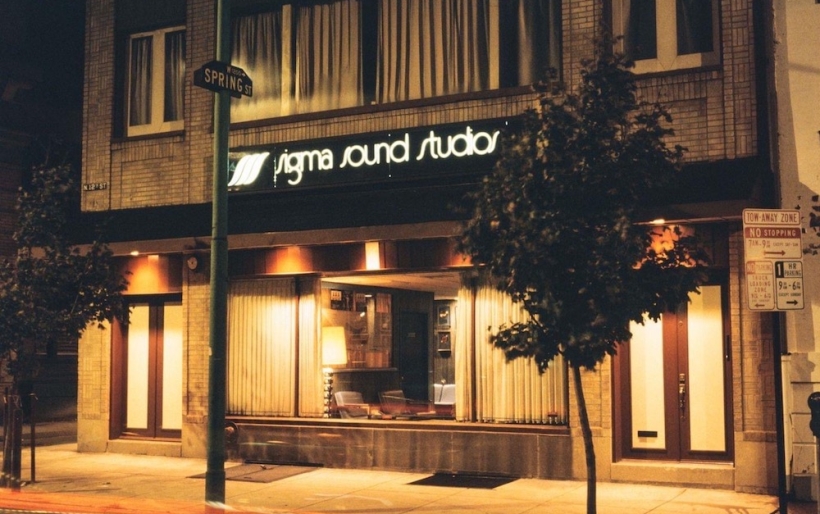
Sigma Sound Studios | photo by Arthur Stoppe
Sigma Sound supporters offer testimony to city officials, but the building’s fate remains in limbo
A two-story building at the corner of Spring and 12th Streets was the birthplace of countless genre-defining hit songs, from The O’Jay’s “Love Train” to David Bowie’s “Young Americans” and Erykah Badu’s “Otherside of the Game.” But the fate of the former Sigma Sound Studios has been uncertain since a developer bought the building in 2015 with plans to convert it into apartments, while members of the music community rallied in opposition.
In a public Zoom meeting this morning, the City of Philadelphia’s Committee on Historic Designation heard fervent testimony from the Preservation Alliance of Greater Philadelphia, as well as other local music advocates, in support of making the Sigma Sound building a historic place.
“Most people probably know [Sigma] even if they don’t realize,” said Patrick Grossi of the Preservation Alliance. “I don’t think it’s hyperbole to think you can’t chronicle the history of 20th century pop music without the story of Sigma.”
His colleague Ben Leech agreed, speaking to the breadth of musicians and producers who have worked at Sigma over the decades.
“This was a rabbit hole I went down willingly and almost didn’t come out of,” Leech said. “I regret maybe not including a compendium playlist [in my testimony]; that might have been most appropriate. Even when I was encountering song titles and artists I didn’t think I knew, of course when I pulled them up online, I did know them. [Sigma] is inextricably woven into our shared cultural heritage.”
The recording studio has been closed since 2013, and in 2015 the building was purchased for $1.55 million by an investment partnership going under the name 210 North 12th Street Investments LLC and 212 North 12th Street Investments LLC, as the Philadelphia Business Journal reported, with loose plans for apartments announced. The building was zoned for condominium development last year, but preservationists called for it to be made a Philadelphia music history museum, as the Inquirer reported in March.
In today’s meeting, the Preservation Alliance’s Leech argued that not only is the building worthy of a historic designation due to its connection to notable people (one of the Commission’s criteria), it is also an specimen of the neighborhood’s history. Leech noted that this area of North Chinatown was once home to a network of industrial buildings supporting the city’s creative community, such as film exchanges and recording spaces. This was “decimated by the construction of the Vine Street Expressway” in the 70s and 80s, Leech said, and the Sigma building remains one of the last standing examples of this era in local history.
Record producer and University of the Arts professor Aaron Levinson spoke to the building’s history as an innovative music space; built in 1930, it was run as Reco-Art Recording from 1958 to 1964 by engineer by Emil Corson, who Levinson notes installed several unique sound-treated recording rooms, such as echo chambers. Sigma Sound’s Joe Tarsia took over the space in 1967, and operated it until the business closed in 2013, and Levinson told the Committee that Sigma’s building has “almost unparalleled significance locally, second only to the RCA Building in Camden…and as far as cultural patrimony goes, I would argue that this building is one of the most significant buildings in the entire nation as far as the history of recorded music.”
Jack McCarthy, a historian and archivist specializing in Philadelphia music history, concurred. “The music made in this building literally changed the world,” he said. “It’s not hyperbole to state that,” Max Ochester of Brewerytown Beats — who has spearheaded much of the organizing around preservation — noted that of the three main studios that thrived in the city’s Sound of Philadelphia heyday of the 70s, Virtu Studios and Philadelphia International Studios have both been torn down, with only Sigma’s building remaining.
“We all know artists like Stevie Wonder and David Bowie,” Ochester said. “Those artists who were not from Philadelphia used this building as a home away from home. They came down in search of this building and what it could potentially do for them and their careers. It’s a very special place.”
The Committee on Historic Designation is an advisory board to the City’s fuller Historical Commission, which ultimately determines whether or not the building is preserved. Nino Tinari, a lawyer representing the property owners, also appeared at today’s meeting, asking that the issue not be sent to the full Commission until “we can get an opportunity to put together our defense, if you can call it a defense, to have this registered as a historical site.” Tinari said his client was notified of this hearing on August 10th, and submitted a request via USPS mail for more time then; city attorney Leonard Rueter reminded him that city offices have been closed since March, with mail only being checked periodically, but the Committee decided (against protests from preservation supporters) to revisit the issue at its next meeting.
While the fate of the Sigma Sound building remains in limbo, the Historic Commission’s executive director Jon Farnham assured the Preservation Alliance that the building would remain as-is. “There are no outstanding building permits,” he said. “There is a zoning permit, but you don’t have anything to worry about in terms of continued protection of the property.”
The next full meeting of the Historic Commission falls on September 11th, with the committee meeting following on September 16th.
